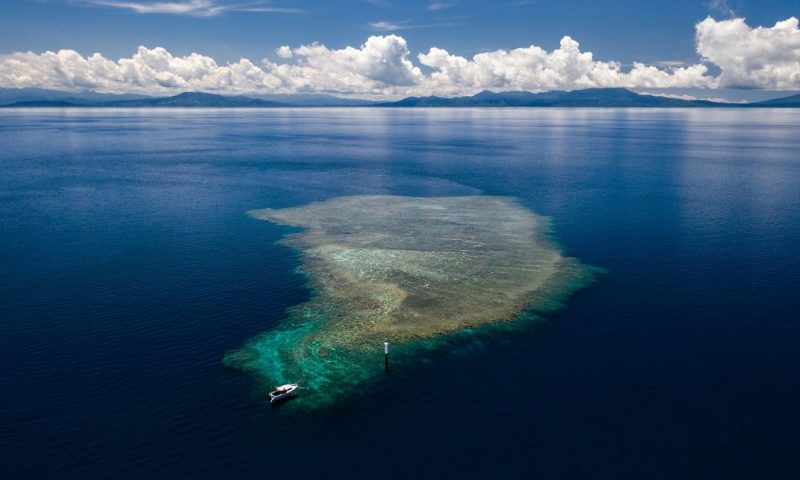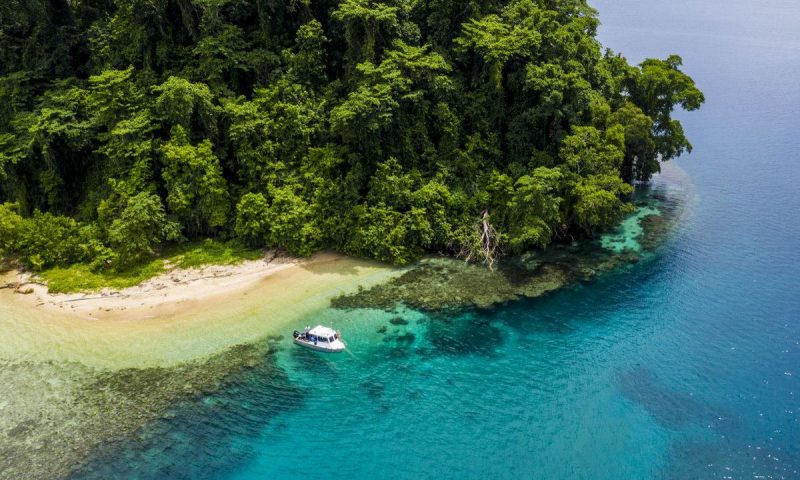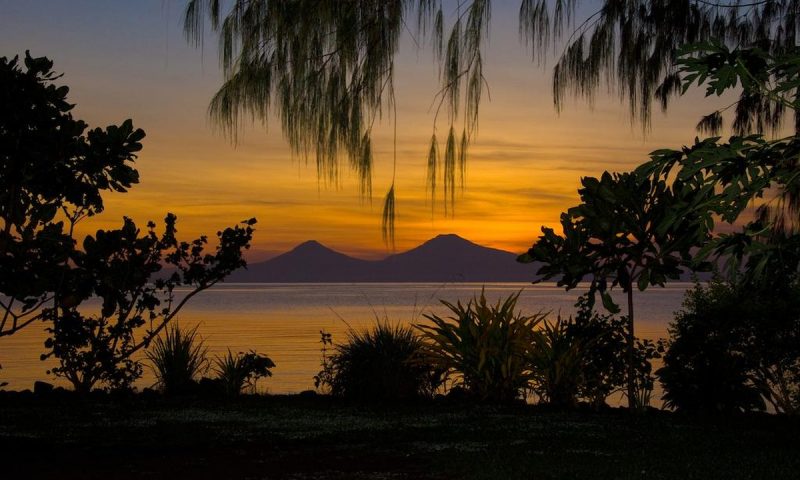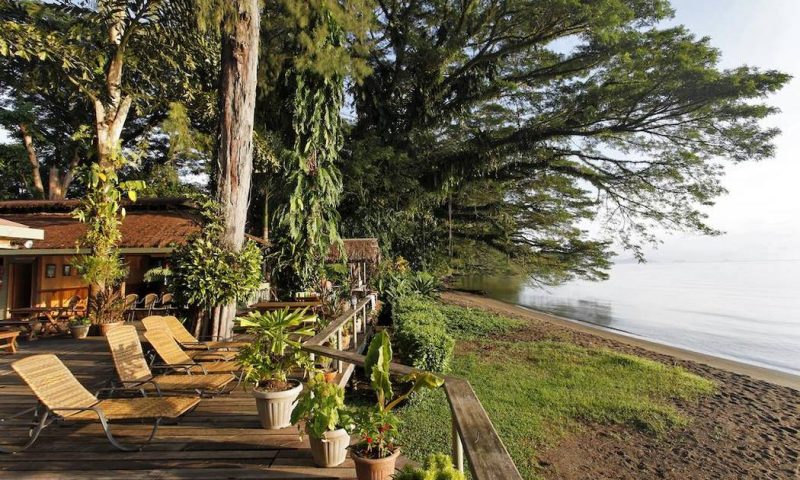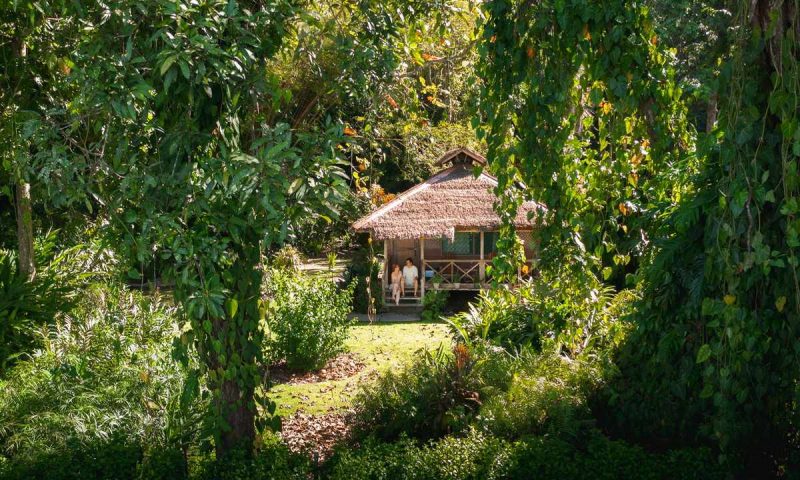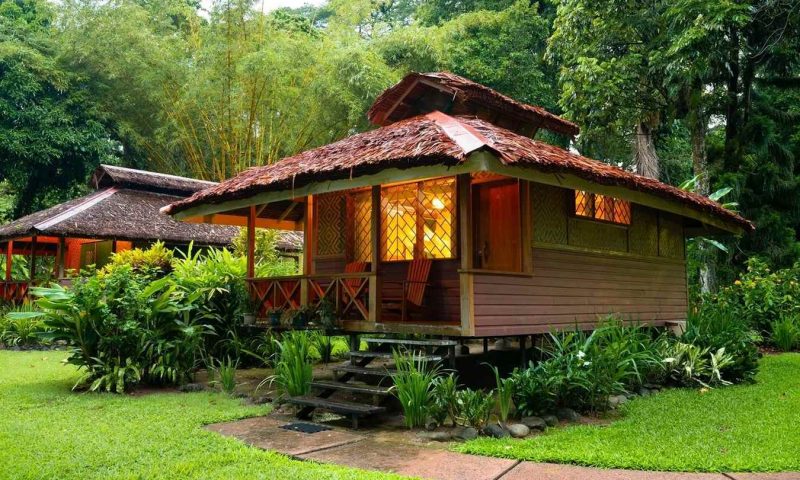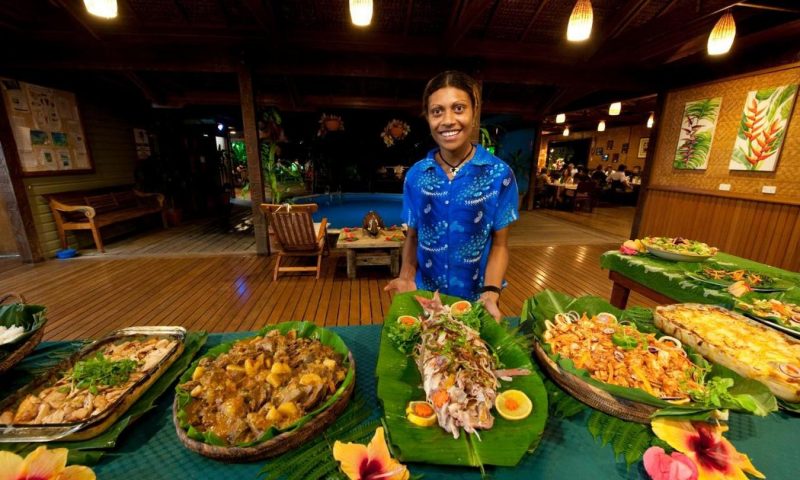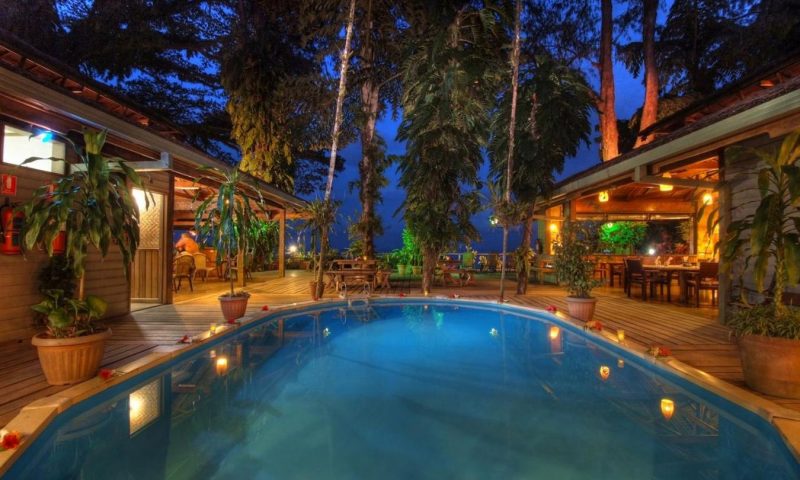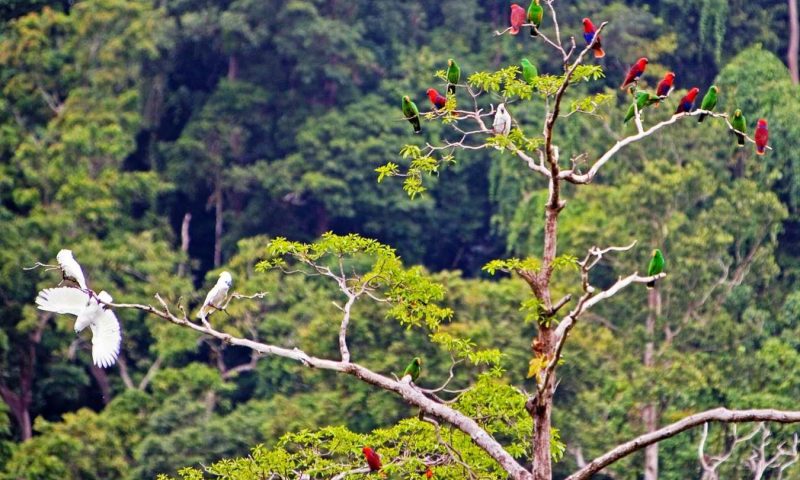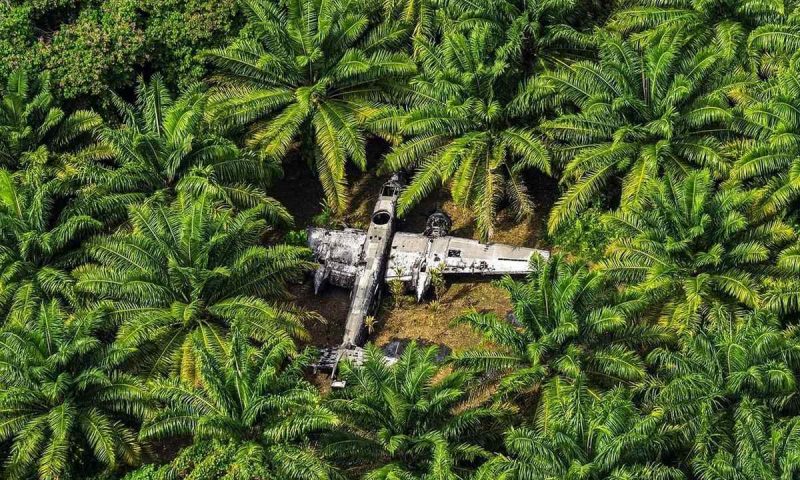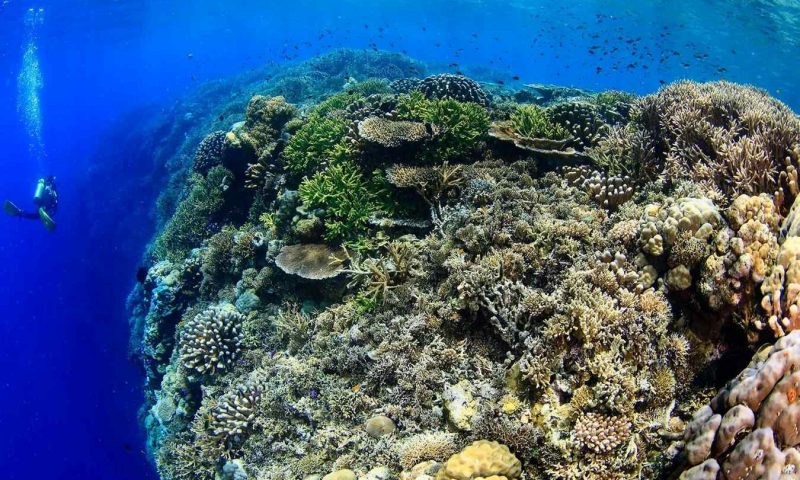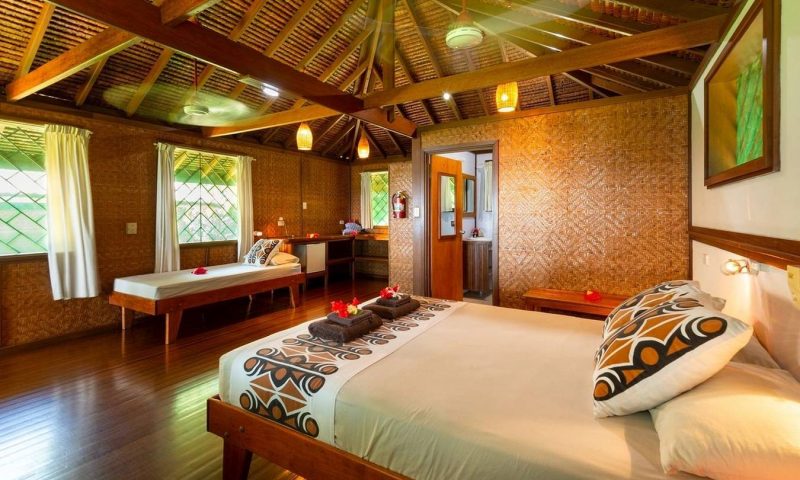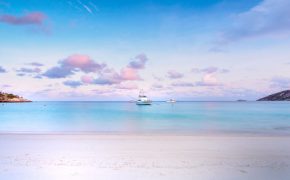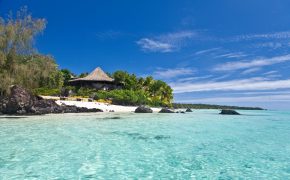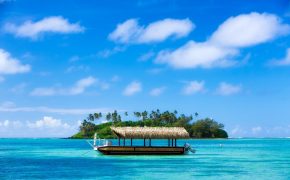The idea to develop the resort came after Max and Cecilie Benjamin travelled overseas for a diving holiday in 1978 where they immediately recognised the outstanding marine biodiversity of Kimbe Bay in their own backyard.
Walindi Plantation Resort commenced on the shores of Kimbe Bay in 1983 and we are a fully family owned resort now reaching three generations. The resort has now grown to incorporate 20 accommodation units, day dive boats and links with two liveaboard dive boats.
Terrestrial outreach such as bird watching, WW2 history, village visits, thermal hot river swimming, volcano climbs as well as scuba diving and snorkeling have expanded the footprint of the resort to include many PNG traditional resource owners.
The drive for environmental education of all concerned, strong environmental protection policies such as using only permanent marine moorings at dive sites plus community consultation practices is central to the resort’s operation ethos today and for the foreseeable future.
ACCOMMODATION
Walindi Resort has two types of rooms, Bungalows (premium room type) and Plantation House Rooms (standard room type).
The Bungalows are free-standing ‘bure’ style accommodation, with ensuite bathroom, ceiling fans (no air-conditioning), tea and coffee making facilities, small fridge, closet, work desk and a private verandah. The Bungalows are located along the beachfront and have water views.
The Plantation House Rooms are slightly smaller, but still with all the same features as the Bungalows. These rooms are built in a block of four sharing a common verandah and have garden views. Room rates include all meals, daily laundry service and wi-fi at the main resort building.
Walindi Resort is proud to support sustainable building design since our foundation in 1983. We care about the environment and have designed the resort and rooms to reduce our impact and deliver effective Eco-standards to our guests.
BUNGALOWS
Bungalows are free standing “bure” style accommodation, built in local timbers and materials. They are nestled in the tropical gardens of Walindi with ocean views.
The bungalows are fan cooled and fully screened. They each have a private verandah and ensuite facilities and are accessed by paths winding through the rainforest gardens. Bungalows can be reserved as a single, twin, double or triple.
PLANTATION HOUSE ROOMS
Plantation House rooms at Walindi are built in blocks of four rooms, constructed with local timbers and materials. The rooms are situated amongst the gardens.
Plantation House Rooms are fan cooled and fully screened. Each room has private ensuite facilities and similar features to the larger bungalow accommodation. Each block shares a common verandah. Plantation House rooms can be reserved as a single, twin or double.
FACILITIES
The central resort area is the social hub of Walindi. Here you will find the tropical and airy reception, Casuarina Restaurant, lounge and bar area (Planter’s Bar), swimming pool, sundeck, Blue Taro Boutique and a comprehensive reference library with TV. Complimentary wireless internet is available in this central building.
CASUARINA RESTAURANT
The restaurant offers three meals daily (included in the tariff) and fare is Western and Asian style, delicious and plentiful, featuring local seafoods, fruits and vegetables. The beef served is produced on neighbouring Numundo Plantation. Meals are at set times. Special dietary requests will be accommodated wherever possible, just let the Manager or Reservations Staff know of your needs prior to arrival.
PLANTER’S BAR
Planter’s Bar is the perfect place to relax and socialise. Share stories with fellow guests or just watch the day draw to a close over the water before dinner. The bar is fully stocked with mixed drinks, beers, a selection of wine, soft drinks, bottled water and snacks and is open for most of the day.
LOUNGE & LIBRARY
The library/lounge is air-conditioned with comfortable seating and an extensive reference library encompassing marine life, underwater photography, local terrestrial life and history information. A small fiction section is also housed. Complimentary tea and freshly ground PNG Highlands coffee are available at all times in the lounge.
POOL & SUNDECK
The resort swimming pool and sun deck are favourite places to relax. Take a cooling dip in the pool or lay on a sun lounger overlooking Kimbe Bay.
ACTIVITIES
Kayaks & Stand Up Paddle Boards are available for in-house guests. Swimming and snorkeling are also possible from the jetty or beach area. See relevant sections for further details on activities such as diving, snorkeling, freediving, land tours and birdwatching.
SCUBA DIVING PAPUA NEW GUINEA
Papua New Guinea is located in the coral triangle, the centre of marine biodiversity which has the highest diversity of tropical fish and coral in the world. The waters of Kimbe Bay are home to prolific and diverse marine life and reef structures.
Pristine and colourful corals are home to a variety of fish, crustacean and invertebrate life and many of the reefs have resident schools of barracuda, tuna and jacks. A range of shark species are regularly sighted, including hammerheads and silvertips, particularly on the offshore reefs.
Resident pods of dolphins frequently entertain divers transiting between sites. The occasional sightings of orcas, pilot whales, whale sharks and other marine life passing through Kimbe Bay waters delight both guests and staff.
Walindi Resort has three purpose-built day boats to take guests out diving and snorkeling the wonderful waters of Kimbe Bay. The Bay with over 40 different sites to choose from, offers a variety of different sorts of dives – underwater sea-mounts, unbelievable sheer walls, fabulous coral gardens, huge fans and funky critters.
Our dive sites are suitable for all levels of diver and whatever the length of your stay, the one thing we can promise is that you will not be bored!
Walindi Resort has a full-service dive centre where our day boats are docked and prepared each day to venture out into Kimbe Bay. The dive centre features a compressor room for refilling tanks including Nitrox and a gear hire room with a full range of dive equipment available for rent.
From the moment you arrive, Walindi Resort does all the heavy lifting so guests can spend more time relaxing and enjoying the beautiful dive sites. Walindi takes care of your equipment, sets it up, packs it down and washes it each day, all guests have to do at the end of the day is step off the boat. All gear is also fully washed, dried and returned prior to check out.
Walindi’s three dive boats were all custom-built in Brisbane according to Australia’s high commercial vessel standards. Each of the three vessels is in the 9-metre range with an exceptionally wide beam for the length and are powered by Suzuki Marine’s most modern engines, ensuring a safe and comfortable ride.
If you enjoy snorkelling, why not try out diving? Or, if you are already a certified diver, why not expand your qualifications? Today scuba diving can be a very easy and pleasurable activity. No, you do not have to invest many days in the classroom and the pool.
Our highly trained instructional staff can guide you gently into this new world. Kimbe Bay offers some of the best conditions to learn to dive, with warm, clear, calm seas and a pristine underwater environment.
Your instructor will take care of the strategic planning and preparations, teach you a few tactical skills and be your personal guide to a fun and secure adventure. Walindi Resort offers the full range of PADI dive courses.
SNORKEL & FREEDIVE PAPUA NEW GUINEA
Kimbe Bay with its warm, clear, calm waters and small rainforest covered islands offers a unique and ideal place for Snorkeling. A large number of Kimbe Bay reefs come close to the surface so are very well suited for snorkeling and is one of the few places in the world where the snorkeling is at least as good (and possibly better in some areas) as the diving.
Pristine and colourful corals are home to a variety of fish, crustacean and invertebrate life and many of the reefs have resident schools of barracuda, tuna and jacks. A range of shark species are regularly sighted particularly on the offshore reefs.
Resident pods of dolphins frequently entertain snorkelers transiting between sites. The occasional sightings of orcas, pilot whales, whale sharks and other marine life passing through Kimbe Bay waters delight both guests and staff. Guests can also snorkel just in front of the resort or use the paddle boards and kayaks available to explore nearby reefs.
The configuration of the bay and its position relative to prevailing winds creates an unusually sheltered environment for the rich complex of seaward reefs.
Coupled with the spectacular underwater terrain, composed largely of steep-sided, patch, saddle, or pinnacle reefs and 100m+ depths just a few hundred metres from the resort jetty, Kimbe Bay offers the most ideal location to train and experience freediving in calm, warm waters with little current.
Walindi designed and custom made ‘Dolphin Nets’ allowing our guests to virtually swim with the pod as they ride the bow of our day boats. This method allows guests, often within touching distance, to watch their behaviour and hear the pod as they communicate with each other and if you are really lucky the same can be experienced with Orcas. These encounters are opportunistic and often occur when travelling between snorkel sites.
TOURS PAPUA NEW GUINEA
Walindi Plantation Resort has developed several exciting land tours exploring New Britain’s rainforests, rivers, volcanoes and wildlife.
For an adventure, hike up the local active volcano; for a more relaxing day visit the natural spa that is the thermal hot river; visit relics of the past with reminders of WW2; wake up early to see the sunrise and look for birds, spend the day at the local village, fly around Kimbe Bay on a scenic helicopter flight or stay up late and watch the natural lightshow of the local firefly trees. There is an adventure to suit all interests.
VOLCANO HIKE
A reasonably arduous hike uphill takes you up to the top of the active Garbuna volcano crater. The innumerable species of flora and fauna you will see in the rainforest on the climb up puts New Britain and the whole of Papua New Guinea on the top of naturalists’ and scientists’ lists.
Starting just at the edge of Walindi Plantation, this trek takes you though lush pristine rainforest, where vast trees rise to form a dense canopy. The route will take you on a gentle climb through the rainforest to the crater on a bush track known only to local guides.
On your way up keep an eye out for interesting insects, birds and plants. The route then comes out in the open scorched valley with steaming vents, volcanic rubble and hot streams.
The hike up will take approximately three hours. The walk back down (along the same route) takes approximately two to three hours. The terrain is steep and can be slippery, but it is a wonderful way to see the Island from a very different perspective.
HOT RIVER
Hidden in the West New Britain tropical rainforest runs a thermal river. It is a wonderful emerald green stream with swirling pools and mini waterfalls, fed by a volcanic spring.
Due to its volcanic source, the river is naturally rich with minerals and high in sulphur, so a brief soak in its waters will leave your skin and hair feeling soft and silky smooth. The water temperature is around 43° Celsius (around 110° Fahrenheit).
Take the opportunity to bathe in warm waters surrounded by rich rainforest and to feel completely rejuvenated, treat your body to a natural exfoliating treatment with the special red mud found along the riverbanks. For a truly unique spa session, the hot river is a must when visiting Walindi Resort.
WWII PLANE WRECKS
For anyone interested in plane wrecks or war history in general, the abandoned New Zealand 4522 Lockheed Vega Ventura and the American B-25H Mitchell Bomber are worth a visit.
In 1944 the B-25H Mitchell crash landed due to engine trouble, damaging the front nose gear and the Lockheed Vega Ventura PV1 took a Japanese 25mm bullet through the starboard engine’s fuel line during a strafing run; both were considered irreparable and scrapped.
A short drive to the north of Walindi, and guests can climb through the vine ridden historic aircraft that are considered the last in the world to have the original outfitting of artillery.
FIREFLIES
For a quick after dinner jaunt, you can visit the local firefly trees where you will encounter whole trees pulsing with the luminous fireflies – a truly amazing natural spectacle.
Located on the very edge of Walindi Plantation Resort’s property, lies a collection of small trees that during the day looks like any other tree in the surrounding rainforest, but at night these trees come alive with thousands of tiny beetles called Fireflies.
These minute beetles flash in synchronous or pulsing waves of light, a magic light show in the forest. It is not entirely known why they have chosen these trees and why they flash like they do but what is certain is it is a natural nocturnal spectacle worth seeing.
HELICOPTER SCENIC FLIGHT
Helicopter scenic flights are available with Niugini Helicopters and is one of the most exciting experiences we offer, flying over the islands of Kimbe Bay, the lush rainforest and pristine volcanic lakes including a low flyover of Gabuna Volcano. Up to 5 passengers can ride in the helicopter with pick up and drop off directly at Walindi Resort with options of 30 minutes or 1 hour flights.
BIRDING PAPUA NEW GUINEA
New Britain is a geological hotspot that holds many endemic species and contributes significantly to the avian diversity of the New Guinea region. A birdwatching tour to Papua New Guinea is not complete without a visit to the Bismarck Archipelago.
Walindi offers the best location for exploring the north coast of New Britain and the Bismarck Sea in comfort. Tours are offered to nearby rainforests and small islets in Kimbe Bay for a host of exotic Bismarck and New Britain endemics.
Exciting species include the Heinroth’s Shearwater, Golden Masked Owl, New Britain Pitta, Nicobar Pigeon, Blue-Eyed Cockatoo, twenty pigeons and doves, nine kingfishers including the Black-Headed Paradise Kingfisher and a host of little known passerines.
DIVE LIVEABOARDS PAPUA NEW GUINEA
Papua New Guinea is located in the coral triangle, the centre of marine biodiversity which has the highest diversity of tropical fish and coral in the world. Whilst on the liveaboards, guests will be diving on some of the most beautiful reefs and sea mounts in the Bismarck Sea, with abundant fish life amongst picturesque and dramatic volcanically formed reefscapes.
The dive liveaboards, MV FeBrina and MV Oceania, offer a variety of itineraries throughout the year tailored to suit changing weather patterns and designed to dive the best of what is on offer in Papua New Guinea. Kimbe Bay itineraries can be combined with your stay at Walindi Resort.
KIMBE BAY – PAPUA NEW GUINEA
Kimbe Bay pulses with life: its coral reefs hold more than half of all species on Earth, a rainbow jungle that more than 900 reef fish species call home. Kimbe Bay is located in the Bismarck Sea, a key area in the global center of marine biodiversity.
The Coral Triangle and Kimbe Bay lie almost centrally within this. Its marine life is remarkable: Kimbe Bay possesses 4 critically endangered, 11 endangered and 173 vulnerable species.
These include the Largetooth Sawfish (Pristis pristis), Pondicherry Shark (Carcharhinus hemiodon), Olive Ridley (Lepidochelys olivacea) and Leatherback Turtles (Dermochelys coriacea), Scalloped Hammerhead (Sphyrna lewini) and Sei Whale (Balaenoptera borealis).
Kimbe Bay’s secret to its rich healthy marine ecosystem is its complex and diverse bathymetry (the measurement of depth of water in oceans, seas or lakes). A narrow coastal shelf fringes the coastline of the bay, descending to oceanic depths of over 1,000m. Along this coastline, fringing nearshore emergent reefs are neighbors to seagrass beds, mangroves and river estuaries forming multiple land-sea interfaces.
Coral reefs in Kimbe Bay are as striking as they are fortunate. Its reefs have been assessed as high diversity and high coral cover sites – amazingly with relatively low human impact. Of the 173 IUCN Redlist vulnerable species, 159 of these are scleractinian corals.
The endangered coral Cantharellus noumeae is also found in the Bay. In 2018, researchers from James Cook University undertook upper mesophotic surveys in Kimbe Bay, which resulted in reporting a species of Black Coral (Antipatharia) that had not been previously described to science, let alone the Bay itself.
The occasional sightings of orca, pilot whales, whale sharks and other large marine life passing through Kimbe Bay often with young are also an indicator of the importance of Kimbe Bay as a habitat for these animals.
The combination of a rich and varied fish fauna, well developed coral reefs, and a spectacular, relatively pristine environment, is ample justification for the establishment of a special conservation status for Kimbe Bay.
KIMBE BAY DIVE SITES
The configuration of the bay and its position relative to prevailing winds creates an unusually sheltered environment for the rich complex of seaward reefs. Coupled with the spectacular underwater terrain, composed largely of steep-sided, patch, saddle, or pinnacle reefs, it is one of the tropic’s most exciting dive areas.
Below are brief descriptions for just some of our favourite reefs around Walindi. We have listed some of the more interesting fish and critters that have been seen at the sites listed, but of course there are no guarantees that you will see them on every dive.
What we can guarantee however, is that you will see vastly more than can ever be described in the brief overviews given here. Take your time and dive carefully, and you will be able to better appreciate what is one of the most diverse and healthy ecosystems on the planet.
AGU REEF
The reef flat of the main reef at Agu is only 1-2m (3-6ft), with a very narrow ridge dropping away to the south. Just under the boat, the mooring is situated at a depth of 5m (16ft), with a gradual ridge sloping down to 20m (65ft) with a ledge at 35m (115ft) before dropping away into the deep.
It is a narrow ridge, so you can either choose to swim along the ridge or along the wall, and either offers a great dive. If there is a good current, hop over to the current side of the ridge and you will see schools of barracuda, batfish, rainbow-runner, big-eye trevally, even a couple of gray reef sharks or dogtooth tuna.
The ridge is covered with hard coral, with many sea anemones with pink anemone fish. In the shallows, hard corals and damselfish make a nice combination and good place to do a safety stop. If you come back from the ridge and still have some spare air, you can explore the wall on the main reef where you should find a good selection of nudibranchs.
ANN SOPHIE’S REEF
Anne Sophie’s Reef is one of Kimbe Bay’s most diverse reefs. Situated at the northern tip of the bay, it is just over an hour’s boat ride from Walindi. The main dive site is at the end of the reef structure running south away from one of the coastal islands.
The top of the reef is in about 5m (16ft) of water, it slopes down onto a sand bottom consisting of small coral bommies covered in a variety of soft coral. The maximum depth onto the sand is 23m (75ft). The reef is made up of a vast amount of varying corals, from hard brain coral and tubastea branching corals to elegant sea fans, black coral trees and barrel sponges.
Along the sand bottom garden eels and goby shrimp can be seen. On the top and along the sides, crabs, scorpion fish, nudibranchs, flatworms and dart fish can be found.
The water column surrounding the reef is abound with fish life such as barracuda, trevally, bat fish, unicorn fish, Moorish idols, parrot fish and damsel fish. On most dives grey reef sharks and turtles have been seen. The dive site can vary with the water movement, from calm, still water to a moving current across the top.
BRADFORD’S SHOAL
Bradford Shoals is a dive site of the sea mount type, an isolated reef that rises from considerable depths to within sixty-five feet (20 meters) of the surface.
The reef structure is predominantly flat plates of hard corals, and adaptation allowing maximum utilization of the reduced sunlight at that depth. There are also many colonies of Leather Coral, Sarcophyton. The reef slopes downward from its twin summits to a lip at about ninety feet (27 meters), after which the drop is almost sheer vertical.
Among the corals are a number of the smaller species of reef fish such as fairy basslets, butterfly fish, and damselfish, and quite a number of pink anemone fish. Interesting as these are, the main reason for visiting Bradford Shoals is big fish, especially pelagics.
The reef seems to act as a magnet for these fish and on any dive one is almost certain to see large schools of Barracudas, Pinjaro, Big Eye Trevally, Dog Tooth Tuna, Unicorn Fish, Fusiliers and Sharks, either Grey reef sharks or on rare occasions a Hammerhead.
CHRISTINE’S REEF
Christine’s Reef begins as a submerged saddle between a large reef and two much smaller detached reefs. While it is quite possible to swim down the saddle, around the first of the detached reefs, and then back up the saddle, the saddle itself is the most interesting.
Starting at the main reef a diver descends down across a thick growth of staghorn corals and quickly reaches the saddle proper to find a beautiful combination of large gorgonian fans, red whip gorgonians, and a few barrel sponges, many of which are adorned with colourful crinoids.
The larger of the two dark red sea fans at the southern end of the saddle is a particularly good place to observe longnose hawkfish. The red sea fans also make an excellent backdrop for photographing the hawkfish or any other fish willing to pose in front of them.
At the northern end of the saddle, just past the gorgonian fans and barrel sponge, are several sea anemones occupied by families of clown anemone fish.
EMA NORTH
North Ema Reef has as its main feature a deep bommie attached to the main reef by an even deeper saddle. The bommie is covered with gorgonian sea fans whose white feeding polyps contrast with their red skeletal structure. Beneath the sea fans is an under story of leather coral. There are also a few colonies of burning bush soft coral.
Because one can remain on the deep bommie only briefly, making a shallow circumnavigation of the main reef is a pleasant way to finish the tank of air and gain an extra measure of decompression.
The east side of the reef is an almost sheer wall along which sea anemones occupied by pink anemone fish occur at almost regular intervals in the ten to thirty foot (3-9 meter) depth range.
The south end of the reef has a more gradual hard coral slope with typical reef fish and an occasional passing school of barracuda. Returning along the west side wall, look for the large sea anemone with orange anemone fish, one of the less common species of Kimbe Bay.
EMA SOUTH
South Ema Reef – if any dive site in Kimbe Bay can be said to have it all, it would have to be South Ema. Huge barrel sponges, red whip gorgonians, colourful soft coral, and a deep swim through are just a few of the attractions.
Descending along the saddle from the main reef a diver passes a few gorgonians and plate corals at just below thirty metres (100ft). Just off the west end of the shoulder, where it begins to rise again, is the entrance to the swim through cave.
Entering through the smaller opening on the north side allows one to better appreciate the gorgonians and sponges that frame the much larger opening at the southern end.
Ascending upward from the shoulder onto the large attached bommie one passes a stand of Dendronephthya soft coral, thickets of red whip gorgonians, and into a cluster of barrel sponges, the largest of them almost two meters (6ft) tall.
The crest of the bommie is covered in hard corals with occasional sea anemones. Fusiliers, trevally, and sometimes barracuda cruise the waters above the bommie. Leafy scorpion fish can also occasionally be found on South Ema.
HANGING GARDENS
This site is Walindi’s House Reef and is a 2 minute boat ride from the jetty. Hanging Gardens is a dive site situated along a sheer vertical wall starting from just below the surface and descending to a depth of about ninety feet/thirty meters where the wall meets a sand and rubble bottom. Along the wall are numerous ledges and overhangs, as well as several large cut backs into the cliff.
The site is named for the many tangles of rope sponge hanging down along the face of the cliff, some up to ten feet/three meters in length and with crinoids clinging to them.
In the shaded areas beneath overhangs and within the cuts are prolific encrusting communities dominated by sponges and sea squirts. These encrusting communities are excellent habitats to search for many small macro subjects like nudibranchs, feather duster worms, and living shells.
Hanging Gardens is also an excellent choice for a night dive when many of the nocturnal animals that hide in the caves and crevices come out to forage.
INGLIS SHOALS
Inglis Shoal is another of Kimbe Bay’s sea mount type of dive site. The isolated reef rises from considerable depths to forty-five feet (14 meters) below the surface. As with Bradford Shoals, the basic reef structure is primarily composed of flat plates and mounds of non-staghorn corals.
In addition there are also large stands of a greyish soft coral, probably Nephthya, and numerous sea anemones, several of them with brilliantly coloured columns. The different sea anemones are inhabited by at least three species of anemone fish- Clarks, Pink, and Spine-cheek.
From the bare patch at its crest, the reef slopes downward on all sides to a lip at about eighty-ninety feet (24-28 meters), after which it falls away in sheer vertical walls.
Like Bradford Shoals, the main appeal of Inglis Shoals is fish action in the waters above the reef. Schools of barracuda, batfish, trevally, fusiliers, or unicorn fish are there on virtually every dive. Grey reef sharks and hammerheads show up with regularity, and there are also numerous cleaning stations and moray eels.
KIRSTY JAYNE’S REEF
Kirsty Jayne’s Reef is a long extending reef, lying north to south. There are two moorings for this reef, and most of the time diving will start from the Christine’s side. The ridge is narrow and starts descending from 5m/16ft and gradually goes down to 25m/82ft, both sides are fringing walls.
The top of the reef is covered with hard corals, barrel sponges and damselfish. A short saddle meets with the end of the other ridge. This then ascends to 17m/55ft. On the other side are numerous red sea whips that line up in two lines. At 17m/55ft there are a couple of gorgonian fans and olive whips surrounded by schools of purple anthias – it is a spectacular view.
Coming back to the Christine side, just beside the boat, there is a boundless coral garden. It is possibly the most attractive point of Kirsty Jayne’s Reef. It is between 5-15m/16-49ft in depth, and is a very nice area for your safety stop.
JOELLE’S REEF
The top of Joelle’s Reef sits in approximately 16 meters (52 feet) of water, and the surface of the reef gently slopes down to 25-30 meters (82-100 feet) before it reaches a vertical drop off, except the southern side of the reef that reaches a depth of around 40 meters (130 feet).
Joelle’s is great for those who love big fish, most of the time you can see schools of Barracuda, Big Eye Trevally, Red Pinjalo, Dog Tooth Tuna and Surgeonfish, and on occasion Hawksbill turtles.
For the shark lovers, you can also catch a glimpse of either Grey Reef Sharks or White Tip Sharks. You will generally see fantastic fish action at Joelle’s when there is at least a small current running. Around the mooring you can also find three types of anemone fish, Pink, Clarks and Spine-cheek.
OTTO’S REEF
Otto’s Point is the steeply descending corner at the north-eastern end of Otto’s Reef. As the point descends it passes through large numbers of disc shaped mushroom corals at about forty feet/12m, and there is a number of brown bladelike sponges at seventy to eighty feet/20-25m. There are also sea anemones with pink anemone fish at several depths along the wall.
Unquestionably, the biggest attraction of the dive is the fish life. Schools of barracuda, trevally, sea perch, fusiliers, and unicornfish feed in the currents just beyond the reef, joined on occasions by sharks and tuna. As they round the point they sometimes come so close to the reef that a diver sitting quietly can almost touch them.
Also of interest is the wall south of the point where, at depths of twenty to fifty feet/6-15m, there are numerous ledges, overhangs, and small caves. The area has a rich growth of many kinds of sponges as well as black corals, reef clams, and ascidians. Within this encrusting community you can find spider crabs, gobies, and sponge-eating dorid nudibranchs.
RESTORF ISLAND
Restorf Island offers more diversity within a short distance from the resort than almost any other Walindi dive site. From the sandy beach a diver almost immediately enters the sand flats in which there are large colonies of garden eels, at least four species of shrimp gobies, burrowing gobies, sand anemones, occasional flatheads and flounders, and (in season) the large excavated nests of yellow margin triggerfish.
A little farther to the northeast is a hard coral reef which has some sea anemones occupied by clown anemone fish near the boat mooring and a dense growth of black coral trees and gorgonians and barrel spongers on its deeper side.
Swimming around to the west side of Restorf Island brings a dive where the reef slopes downward in a patchwork of loosely connected bommies, many serving as anchors for gorgonian fans, black coral trees, sea whips, barrel sponges, and elephant ear sponges. Among these live many species of smaller nudibranchs, shrimp, feather duster worms, and an occasional octopus.
SUSAN’S REEF
Dense stands of Red Whip Gorgonians, Ellisella sp., give Susan’s Reef a unique aesthetic quality that sets it apart from other Walindi reefs, a feeling which is heightened by clinging tangles of colourful crinoids.
The sea whips are most numerous at the reef’s southern end between seventy-five feet (22m) and fifty-five feet (15m) as it rises up from a saddle that connects the dive site to the much larger Vanessa’s Reef.
Susan’s Reef extends in a northerly direction with a sheer wall on its east side and a sloping garden of hard corals on the west. At the crest of the connecting saddle, at about eighty feet (25m), are some pale sea fans, and when the current is right a few small sea pens push up through the sand to feed.
Continuing upward past the sea whips a diver comes upon three large red sea fans. The deepest, at forty-six feet (14m), is a good place to find the long-nose hawk fish. Above the thirty-foot (10m) depth, the reef is almost exclusively composed of dense staghorn corals among which are a few sea anemones, which serve as hosts to three different kinds of anemone fish.
VANESSA’S REEF
Vanessa’s Reef is a submerged shoulder that extends westward from a much larger reef at a depth of fifty to sixty feet/fifteen to eighteen meters. Its primary attractions are a multitude of large dark red gorgonian sea fans, and farther out on the shoulder, a sponge garden.
Many of the sea fans are eight to ten feet/two to three meters across, or more, and make picturesque backdrops for diver shots. The fans are also a good place to look for hawk fish, commensal shrimp, and other macro subjects.
The sponge garden includes many bright orange sponge mounds. Many of the sponges have heaps of crinoids clinging to them, affording the crinoids and elevated position from which to feed in the current.
Near the end of the sponge zone, in 60 feet/18 meters of water, is the boat mooring, beyond which there is a sparser mixture of sponges and sea fans. On both sides of the shoulder the reef slopes downward to a sandy bottom. To the north there are additional ridges and ravines, and more sea fans.
